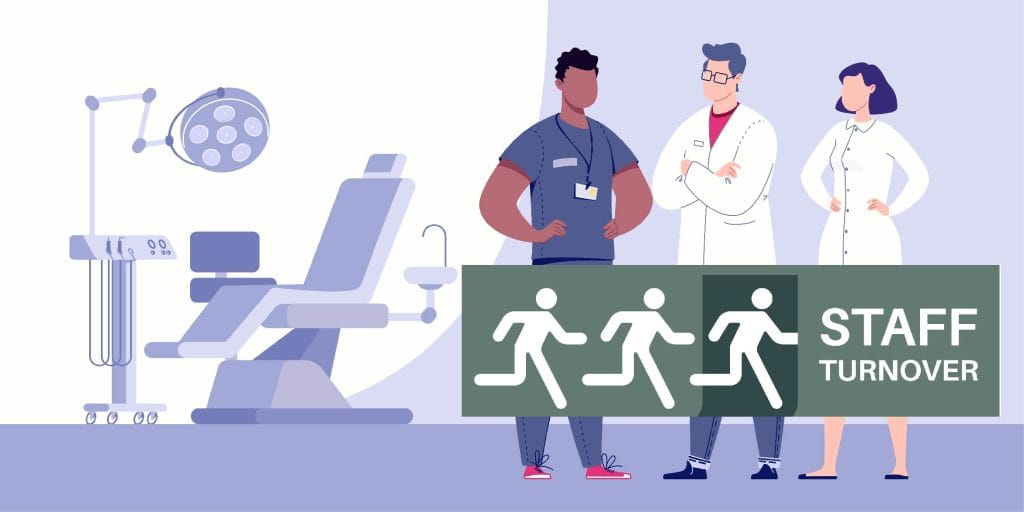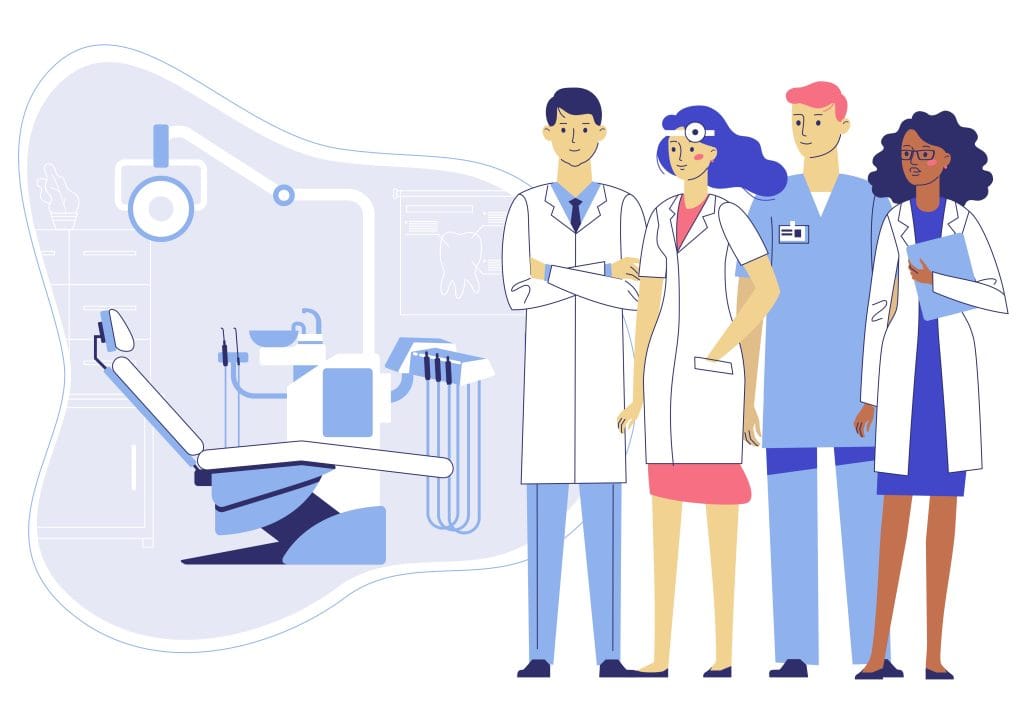Last updated on January 26th, 2021 at 12:31 pm
 Q: I’m looking for ways to boost my production. Should I add another operatory?
Q: I’m looking for ways to boost my production. Should I add another operatory?
The first thing I’ll say is that this decision would be influenced by a number of factors, the least of which would include:
- How many chairs you already have.
- How far you are scheduled out and whether or not you are scheduled properly (effectively).
- How many new patients you are seeing on an average month and how quickly a new patient can be seen (i.e. how long it takes to get them on the schedule).
- Treatment acceptance: could this be improved? Are you running at a low level (as a percentage)? This would include new patients and patients of record.
- And lastly how is your hygiene department configured? And what is your hygiene compliance percentage? In other words, what percentage of your patient base are showing up for regular hygiene visits?
(Related: 5 Simple Ways to Boost Hygiene Production)
To give you dead on, intelligent advice (a definitive yes or no), I would need to know a little bit more about your office, specifically about one through four above. But I do have some advice to help you make a decision.
Now as you know, if you only have two chairs and you have an established practice, i.e. you been around for a couple of years and have 1,000 or more charts, you probably need another chair now. Two chairs, especially with a hygienist, just does not work in the long-term. I have seen specific situations where it can, but it’s not ideal.
 If this isn’t the case, then in the right situation, adding an op can unlock higher levels of production…but I’ve also seen many dentists add one or more chairs and end up with nothing more than a higher overhead due to loans, leases, etc. Adding a chair isn’t going to just get you more new patients. It’s not a case of, “build it and they will come.” In a number of cases, when a dentist is scheduled way out into the future, it’s not due to being overly productive. More often than not, it’s because they are not scheduling properly or your patients aren’t accepting full cases. The schedule is “booked,” but not productive.
If this isn’t the case, then in the right situation, adding an op can unlock higher levels of production…but I’ve also seen many dentists add one or more chairs and end up with nothing more than a higher overhead due to loans, leases, etc. Adding a chair isn’t going to just get you more new patients. It’s not a case of, “build it and they will come.” In a number of cases, when a dentist is scheduled way out into the future, it’s not due to being overly productive. More often than not, it’s because they are not scheduling properly or your patients aren’t accepting full cases. The schedule is “booked,” but not productive.
(Related: 6 Quick Fixes for Low Production)
A rule of thumb for a fully optimized, organized practice (where patients are accepting treatment and getting healthy) is $50,000 per op per month. Now of course this number will go up or down depending on where your practice is and the relative cost of living in your area. A practice in New York City might be expected to do more per operatory as opposed to a practice in rural Wyoming, but this is a good rule of thumb. If you aren’t producing enough per op, you’d be trying to solve the wrong thing by adding another. If you find yourself in this situation, the first thing I’d do is investigate why, and fix those problems first, before you increase your overhead.
Scheduling, case acceptance, or efficiency issues are usually cheaper and easier to fix than adding another chair. And if you ignore them and just add another one, it can simply amplify those problems and you find yourself in a worse position.
(Related: A “Full” Schedule is Not Always a Productive Schedule)
So to address your question, my answer is to make sure that you’re producing a sufficient amount with the chairs that you already have. If you are not, fix those problems first. If you are already producing enough out of each chair, then great! Knock yourself out and add another chair.
If you don’t know why you’re not producing enough per chair, give us a call and we’d be happy to do a free consultation to figure it out and explain it to you.
Q: I’m trying to hire new staff and I’m going through resumés now. What should I be looking for?
The most important issues (at least for me) when hiring someone are:
- Ability to effectively perform the job I’m hiring for (even if I have to train them)
- Their ability to pick things up quickly, and
- Their attitude
If they have a good attitude, have the potential to perform the job and pick things up fast, I can teach them virtually anything.
(Related: Where to Find New Dental Office Staff)
Resumés can give you a clue about this but don’t tell you everything you need to know. For that matter, I’ve seen plenty of candidates who I wouldn’t hire (they would not be a very good fit), that had beautiful resumés.
You can end up with a problem if you do what most dentists do: comb through resumes for a while and then contact what appeared to be the best candidates based on resumés alone and have them come in for individual interviews.
This can be a problem because “go-getter” types tend to move fast and get a new job quickly (not in every case, but usually). So you have to move fast! Plodding through stacks of resumes and then spending an inordinate amount of time deciding who to call means that you’ll miss out on some potentially good employees. They will have already found a job. You moved too slowly! And truthfully, you can’t judge what a person’s attitude and interpersonal skills are like from a piece of paper anyways, so taking too long on this step is wasted time.
(Related: 4 Tips for Hiring Great Front Office Staff)
The best way I have found to hire and get the kind of candidates in front of you that you want to talk to is:
- Move as quickly as possible, which means eliminate the “send me your resume” step and have them just call in and get scheduled for a group interview. They should bring their resume with them to the meeting.
- Conduct group interviews first. Don’t schedule individual appointments, because you don’t have time for that. Group interviews are quick. You get in front of a lot of people in a short amount of time. The purpose of a group interview is to select the people that you’re looking for (i.e. have good attitude and are trainable) vs. the people that wouldn’t be a good fit in your business. Once you have isolated those one or two good candidates in your group interview, then you can do an individual interview and go through their resume and do your usual one-on-one.
The fact is (and I’ve seen this proven time and time again): out of every 10 or 15 people that apply, you may have one person that actually fits what you’re trying to find. In the past, if you haven’t interviewed at least 10 people for jobs you’ve filled, maybe you got lucky—but more likely you got desperate after doing a few interviews and settled with someone who wasn’t quite right for the position because you didn’t have the time or energy to do more interviews.
Therefore we recommend group interviews. I wouldn’t, on the other hand, recommend a group interview for associate doctors or hygienists; stick to the individual ones on these (For more information on finding a good associate you can also check out this article from our blog). If you don’t know how to do a group interview effectively, contact us and we’ll be happy to provide the basic format for you. There’s definitely a right way and a wrong way to do a group interview, so we’ll give you some direction.
(Related: The Tough Stuff: Letting Employees Go)
Q: How do I go over monthly numbers with my staff without making it seem like that’s all I care about?
When you own a business, that business has certain products or services that you’re supposed to produce or deliver. If you owned a bicycle shop, you’d sell and service bikes. If you owned a bakery, you’d do the same with bread, cakes, cupcakes, etc. (Now I’m getting hungry…) What your numbers represent (and these numbers are what show up as statistics) is how many products or services your business is making/performing and then delivering into the hands of your customers (and whether or not you’re getting paid for it). So numbers and statistics are a tool that an executive uses to see how much “product” the organization is making, how many customers you’re getting, and how much product you are selling and getting paid for.
(Related: Should You Share “The Numbers” With Your Staff?)
So the first thing your staff has to understand is what your business produces. If you ask your staff just that, you’d be amazed by the kind of answers you get back. As a dentist, your business product is a healthy patient—not a “healthier” patient. In other words, a patient that has had ALL necessary dental work (i.e. restored dental health and function to the best of your ability) and is referring their friends and family. Not someone who walked in unhealthy (i.e., gum disease, five or six teeth that needed major restorative work, etc.) and did a scaling and one or two crowns and essentially walked out unhealthy—even though they are “healthier” than before.
 When we’re talking about the new patient statistic, it represents how many people in your community that you are reaching, taking responsibility for and getting healthy. When you’re talking about the collections statistic, you are talking about how many patients paid (made a commitment) to becoming fully healthy. And so it goes with statistics such as production, etc.
When we’re talking about the new patient statistic, it represents how many people in your community that you are reaching, taking responsibility for and getting healthy. When you’re talking about the collections statistic, you are talking about how many patients paid (made a commitment) to becoming fully healthy. And so it goes with statistics such as production, etc.
(Related: Making Time for the “Business Side” of Dentistry)
Where statistic management goes wrong is when the focus is on the numbers only, as opposed to what’s behind that numbers. In other words, if your collections are down this month, that means you helped less people get healthy than you did the prior month. Nobody won in that scenario, especially the patients—since the very reason your business exists at all is to help as many people as you can on a continually expanding basis. You see how it’s a different focus? And funnily enough, if your focus is on helping people the stats begin to take care of themselves.
To learn more about the subjects above, attend any of our one-day free seminars: The How to Build Your Dental Dream Team Seminar and the Effective Case Acceptance Seminar, both are held all across the United States and Canada. Also, I highly recommend signing up for our online training platform, DDS Success, so you can train all of your staff online!




No Comments
Be the first to start a conversation